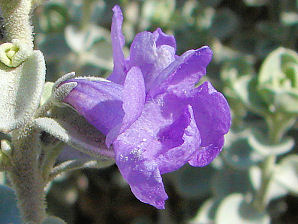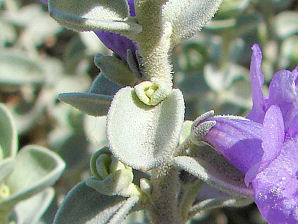Xeriscape Landscaping Plants For The Arizona Desert Environment.
Pictures, Photos, Information, Descriptions,
Images, & Reviews.
Shrubs.
Violet Silverleaf Sage, Leucophyllum candidum.
We Are Proud Of Our SafeSurf Rating!
Click On Any Of The Following Links By Amazon.Com
For Books, & Videos About Wildflowers Of Arizona & The Southwest USA. No Obligation!
 |
| Violet Silverleaf Sage, Leucophyllum candidum. March 22, 2006. Phoenix, Arizona. |
|---|
 |  |
| Violet Silverleaf Sage. Leucophyllum candidum. | Violet Silverleaf Sage. Leucophyllum candidum. |
|---|
 /
/

Violet Silverleaf Sage.
We wish to thank Wikipedia, the free encyclopedia for some of the information on this page. We share images and information with Wikipedia. A low evergreen shrub, or herbaceous perennial shrub. This plant is attractive to bees, butterflies and/or birds. Drought-tolerant; suitable for xeriscaping. Does not do well if overwatered. With its intense violet flowers that appear in the summer through fall in response to humidity or rainfall, it is an eye-catching plant. There are hybrids of this plant available. Called the 'Cloud Series'.
Quick Notes:
Height: 5 - 8 feet tall, spread 4 to 6 feet.
Flowers: Five-lobed tubular 1/2 - 1 inch flowers covering the plants with white, pink, lavender, purple, or blue blossoms.
Blooming Time: Late February - March. Again during the monsoon rains in Arizona.
Leaves: Leaves have a silver pubescence and an attractive felty touch. The leaves are wavy, oval, and 1/2 - 1 inch alternating leaves.
Found: The USDA claims Leucophyllum candidum is native to the USA (TX). It is native to only Brewster County in Texas. It is also native to Mexico in Chihuahua, Coahuila, Nuevo Leon, & Tamaulipas.
Elevation: Native from 2,200 - 4,900 feet.
Hardiness:
Soil pH requirements:
Sun Exposure:
Habitat: Alkaline, well-drained/light soils. An ideal landscape plant in Arizona.
Miscellaneous: Flowering Photos Taken March 22, 2006. Phoenix, Arizona. Water slightly in Phoenix. Does best without fertilizer.
|



We Are Proud Of Our SafeSurf Rating!
Click On Any Of The Following Links By Amazon.Com
For Books, & Videos About Xerioscape Plants Of Arizona & The Southwest USA. No Obligation!
Back To Arizona Xeriscape Landscaping Main Page.
Back To Xeriscape Shrubs Page Three.
Back To Arizona Wild Flowers Home Page
Back To DeLange Home Page
© 1966 - Present, Audrey, Eve, & George DeLange
| © 1966 - Present, Audrey, Eve, & George DeLange |


